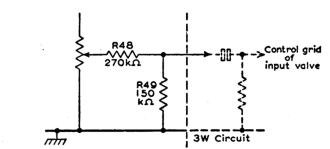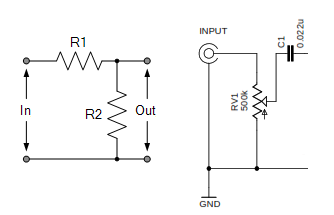People has objected that the input sensitivity of the Model 1955 tube amplifier is too high for use with a CD player.
The standard CD-player output voltage is 2V RMS, with units varying between 1.74V on the low side and a whopping 7.2V on the high side.
The sensitivity of the Model 1955 amplifier with the volume control at maximum is 0.1V RMS.
We need to divide by 20 the input signal, since 2V / 20 = 0.1V.
We can put a 1/20 = 0.05 resistor attenuating network at the input of each channel, either inside the amplifier or outside on the cable that runs from the CD player to the amplifier. That is 2V x 0.05 = 0.1V.
This basic attenuator is a simple voltage divider network used in many electronical circuits.


In either case the attenuation is given by

In the case of the external attenuator, it is advisable for R2 to be about one tenth or less of the resistance of the 500 K volume potentiometer, 50 or 47 K Ohm it’s a good value.
We can also use the volume potentiometer as R2, so R2 = 500k and we only have to put R1

The following solution is the best and simplest. It involves connecting a resistor in series with the input terminal, and it can be implemented in three different ways: outside the amplifier by connecting it to the RCA cable connector, inside the amplifier on the input RCA connector, or on the volume potentiometer.

In our case we need an attenuator of 0.05 then

We can use a standard resistor value of 9.1 MOhm or 8.2 MOhm – A slightly lower value is better in order to get the maximum volume from the amplifier.